Research on Image Denoising in Edge Detection Based on Wavelet Transform
Abstract
1. Introduction
2. Study Area and Data
2.1. Study Area
2.2. Data
3. Materials and Methods
3.1. Wavelet Transform
3.2. Data Processing
3.2.1. Selecting Wavelet Function and Number of Levels
3.2.2. Image Denoising
4. Results and Verification
5. Analysis and Discussion
6. Conclusions
- A bridge image taken in Wenzhou was chosen for study and analysis. The wavelet transform was used to denoise the image before extracting the bridge edges to improve the signal-to-noise ratio of the image. In the wavelet transform, four wavelet functions (sym5, db5, coif5 and fk6) and four decomposition levels (two, three, four and five levels) were used to decompose the image, followed by coefficient filtering and reconstruction to obtain the denoised image. The results show that the sym5 wavelet function performs best in the three-level decomposition, with PSNR and MSE of 23.48 dB and 299.49, respectively. The canny algorithm was used to detect the edges of the images before and after denoising, and it is obvious that the edge detection of the images was better after wavelet transform denoising.
- In addition, the improvements of edge detection by Gaussian filtering and wavelet transform were compared and discussed. The Pratt quality factors of the two methods were 0.47 and 0.53, respectively, which shows that wavelet transform noise removal has better quality factors compared to Gaussian filtering. Thus, the effect of edge detection was improved. In summary, the use of wavelet transform to remove noise can provide a favorable method for edge detection and can lay a solid basis for the daily maintenance of bridges and related scientific research work.
Author Contributions
Funding
Institutional Review Board Statement
Informed Consent Statement
Data Availability Statement
Acknowledgments
Conflicts of Interest
References
- Sekehravani, E.A.; Babulak, E.; Masoodi, M. Implementing canny edge detection algorithm for noisy image. Bull. Electr. Eng. Inform. 2020, 9, 1404–1410. [Google Scholar] [CrossRef]
- He, Y.; He, H.; Xu, Y. Marine Multi-Target Detection Based on Improved Wavelet Transform. In Proceedings of the 2019 3rd International Conference on Electronic Information Technology and Computer Engineering (EITCE), Xiamen, China, 18–20 October 2019; IEEE: New York, NY, USA, 2019; pp. 804–811. [Google Scholar]
- Dris, E.; Bentahar, M.; Drai, R.; El Mahi, A. A0 Lamb Mode Tracking to Monitor Crack Evolution in Thin Aluminum Plates Using Acoustic Emission Sensors. Appl. Sci. 2022, 12, 12112. [Google Scholar] [CrossRef]
- Li, C.Y.; Wang, C.; Yang, Q.X.; Qi, T.-Y. Identification of Vehicle Loads on an Orthotropic Deck Steel Box Beam Bridge Based on Optimal Combined Strain Influence Lines. Appl. Sci. 2022, 12, 9848. [Google Scholar] [CrossRef]
- Huang, Z.; Zeng, X.; Wang, D.; Fang, S. Noise Reduction Method of Nanopore Based on Wavelet and Kalman Filter. Appl. Sci. 2022, 12, 9517. [Google Scholar] [CrossRef]
- Xuan, L.; Hong, Z. An improved canny edge detection algorithm. In Proceedings of the 2017 8th IEEE international conference on software engineering and service science (ICSESS), Beijing, China, 20–22 November 2017; IEEE: New York, NY, USA, 2017; pp. 275–278. [Google Scholar]
- Qiang, L.; Yuting, D. Canny Edge Detection Algorithm Based on lmproved Kalman Filter. World Sci.-Tech. RD 2013, 35, 216. [Google Scholar]
- Kimlyk, M.; Umnyashkin, S. Image denoising using discrete wavelet transform and edge information. In Proceedings of the 2018 IEEE Conference of Russian Young Researchers in Electrical and Electronic Engineering (EIConRus), Moscow, Russia, 29 January–1 February 2018; IEEE: New York, NY, USA, 2018; pp. 1823–1825. [Google Scholar]
- Ali, M.N.; El-Dahshan EL, S.A.; Yahia, A.H. Denoising of heart sound signals using discrete wavelet transform. Circuits Syst. Signal Process. 2017, 36, 4482–4497. [Google Scholar] [CrossRef]
- Saravani, S.; Shad, R.; Ghaemi, M. Iterative adaptive Despeckling SAR image using anisotropic diffusion filter and Bayesian estimation denoising in wavelet domain. Multimed. Tools Appl. 2018, 77, 31469–31486. [Google Scholar] [CrossRef]
- Liu, F.; Han, X. Image Classification of Landing Landform Based on Wavelet Transform and Deep Network. Acta Electonica Sin. 2021, 49, 2171. [Google Scholar]
- Chen, C.; Seo, H.; Zhao, Y. A novel pavement transverse cracks detection model using WT-CNN and STFT-CNN for smartphone data analysis. Int. J. Pavement Eng. 2021, 23, 4372–4384. [Google Scholar] [CrossRef]
- Singh, A.; Kushwaha, S.; Alarfaj, M.; Singh, M. Comprehensive Overview of Backpropagation Algorithm for Digital Image Denoising. Electronics 2022, 11, 1590. [Google Scholar] [CrossRef]
- Rhif, M.; Ben Abbes, A.; Farah, I.R.; Martínez, B.; Sang, Y. Wavelet transform application for/in non-stationary time-series analysis: A review. Appl. Sci. 2019, 9, 1345. [Google Scholar] [CrossRef]
- Kamal NA, M.; Bakar, A.A.; Zainudin, S. Optimization of Discrete Wavelet Transform Feature Representation and Hierarchical Classification of G-Protein Coupled Receptor Using Firefly Algorithm and Particle Swarm Optimization. Appl. Sci. 2022, 12, 12011. [Google Scholar] [CrossRef]
- Song, P.; Tan, Y.M.; Li, X.H.; Guo, H.; Zhang, L.J. Research on Power-line lnterference Removal Method of Ultraviolet Communication Signal Based on Wavelet Transform. Acta Photonica Sin. 2021, 50, 31. [Google Scholar]
- Kuo, J.Y.; Hsu, C.Y.; Wang, P.F.; Lin, H.-C.; Nie, Z.-G. Constructing Condition Monitoring Model of Harmonic Drive. Appl. Sci. 2022, 12, 9415. [Google Scholar] [CrossRef]
- Wu, Y.; Mu, C.; Zong, Q.; Wu, J.; Zhou, H. Study on Blasting Vibration Control of Brick-Concrete Structure under Subway Tunnel. Appl. Sci. 2022, 12, 10960. [Google Scholar] [CrossRef]
- Osadchiy, A.; Kamenev, A.; Saharov, V.; Chernyi, S. Signal processing algorithm based on discrete wavelet transform. Designs 2021, 5, 41. [Google Scholar] [CrossRef]
- Zhang, Y.X.; Li, C.; Jia, J.; Fang, D.Y. A new approach for optimal decomposition level selection in wavelet de-noising. Appl. Mech. Mater. 2013, 333, 540–545. [Google Scholar] [CrossRef]
- Kadir, R.; Saha, R.; Akhter, M.M.; Awal, M.A.; Kadir, M.I. LDPC coded hybrid discrete cosine transform and Fejér–Korovkin wavelet transform-based SC-FDMA for image communication. Array 2021, 12, 100107. [Google Scholar] [CrossRef]
- Pavan, B.; Rani, P.E. Eeg Signal De-Noising Based on The Fejer-Korovkin Wavelet Filter. J. Theor. Appl. Inf. Technol. 2021, 99, 17. [Google Scholar]
- Kharchenko, V.; Kuzmenko, N.; Ostroumov, I. An investigation of synthetic aperture radar speckle filtering and image segmentation considering wavelet decomposition. In Proceedings of the 2019 European Microwave Conference in Central Europe (EuMCE), Prague, Czech Republic, 13–15 May 2019; IEEE: New York, NY, USA, 2019; pp. 398–401. [Google Scholar]
- Zheng, J.; Hou, R. Selection of wavelet base in denoising of wavelet transform. J. Shenyang Univ. 2009, 21, 108–110. [Google Scholar]
- Loseva, E.; Lozovsky, I.; Zhostkov, R.; Syasko, V. Wavelet Analysis for Evaluating the Length of Precast Spliced Piles Using Low Strain Integrity Testing. Appl. Sci. 2022, 12, 10901. [Google Scholar] [CrossRef]
- Xiaodong, D.; Xiangdong, G.; Shaoduo, L.; Dan, H.; Chunrong, P. Study on soft-hard threshold compromise denoising method for weld forming measurement. Trans. China Weld. Inst. 2021, 42, 51–55. [Google Scholar]
- Hsia, C.H.; Yang, Z.H.; Wang, H.J.; Lai, K.-K. A New Enhancement Edge Detection of Finger-Vein Identification for Carputer System. Appl. Sci. 2022, 12, 10127. [Google Scholar] [CrossRef]
- Wang, S.; Lai, Z.; Tan, G. Edge Detection of Strong Noise Image Based on WMF and Improved Canny Algorithm. In Proceedings of the 2021 IEEE 3rd Eurasia Conference on IOT, Communication and Engineering (ECICE), Yunlin, Taiwan, 28–30 October 2021; IEEE: New York, NY, USA, 2021; pp. 252–256. [Google Scholar]
- Huang, H.; Dong, L.; He, J. Edge Detection of an Improved Canny Algorithm under Strong Noise. Comput. Technol. Dev. 2021, 31, 83–87. [Google Scholar]
- Mohan, C.R.; Chouhan, K.; Rout, R.K.; Sahoo, K.S.; Jhanjhi, N.Z.; Ibrahim, A.O.; Abdelmaboud, A. Improved Procedure for Multi-Focus Images Using Image Fusion with qshiftN DTCWT and MPCA in Laplacian Pyramid Domain. Appl. Sci. 2022, 12, 9495. [Google Scholar] [CrossRef]
- Cai, H.; Zhang, G.; Zhang, H.; Zhou, Z. Novel edge detection method based on multiple information measures fusion. J. Zhejiang Univ. Eng. Sci. 2008, 42, 1671–1675. [Google Scholar]
- Daubechies, I. Ten Lectures on Wavelets; Society for Industrial and Applied Mathematics: Philadelphia, PA, USA, 1992. [Google Scholar]
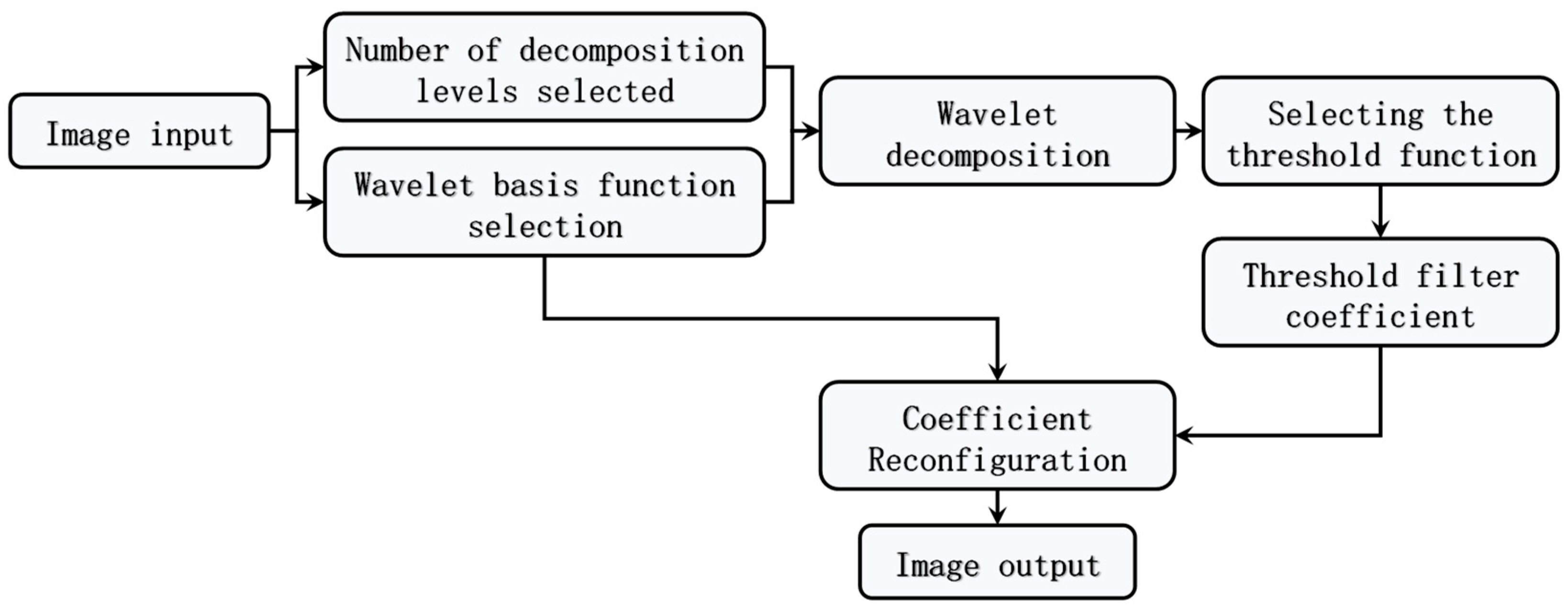


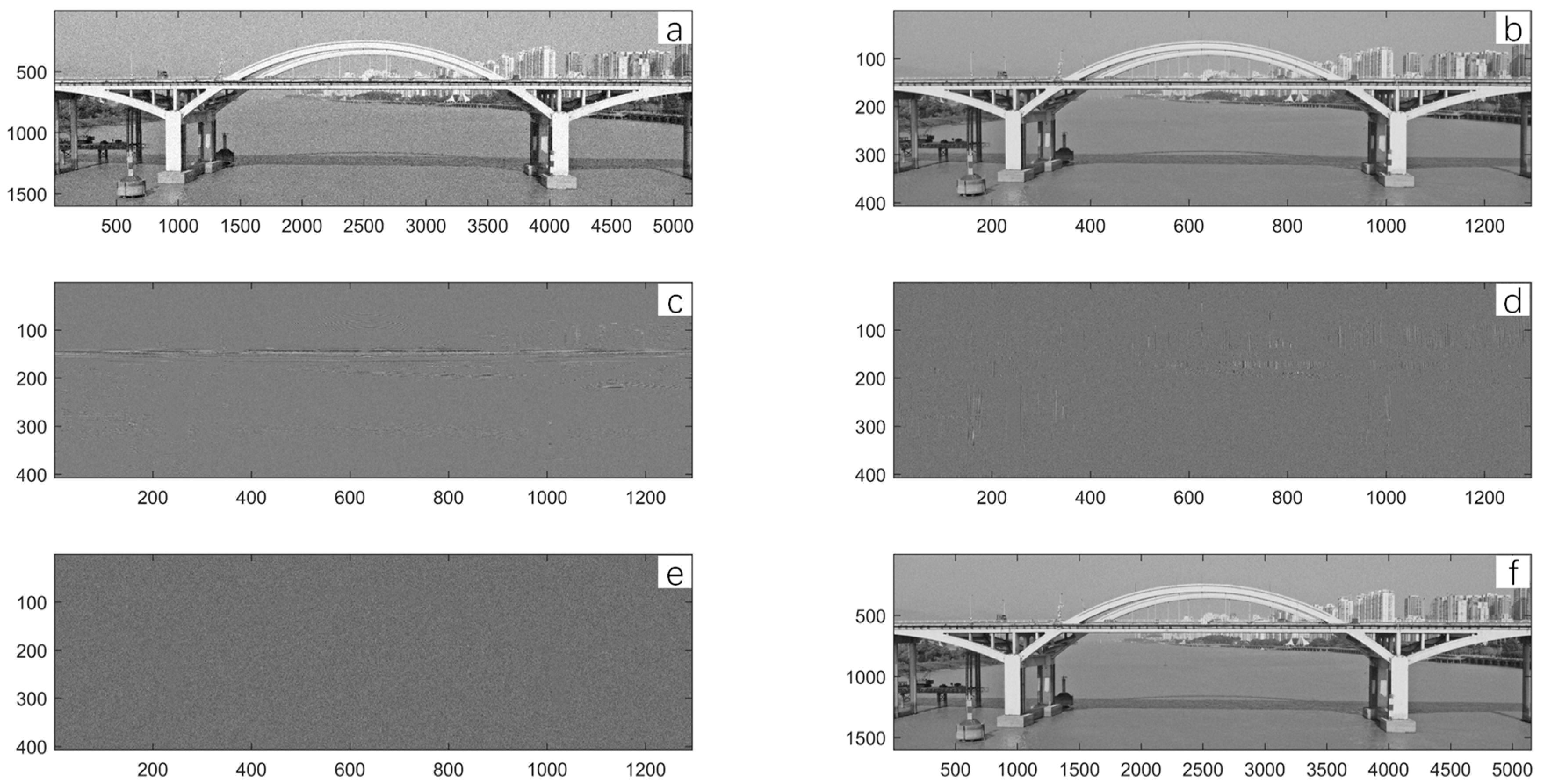
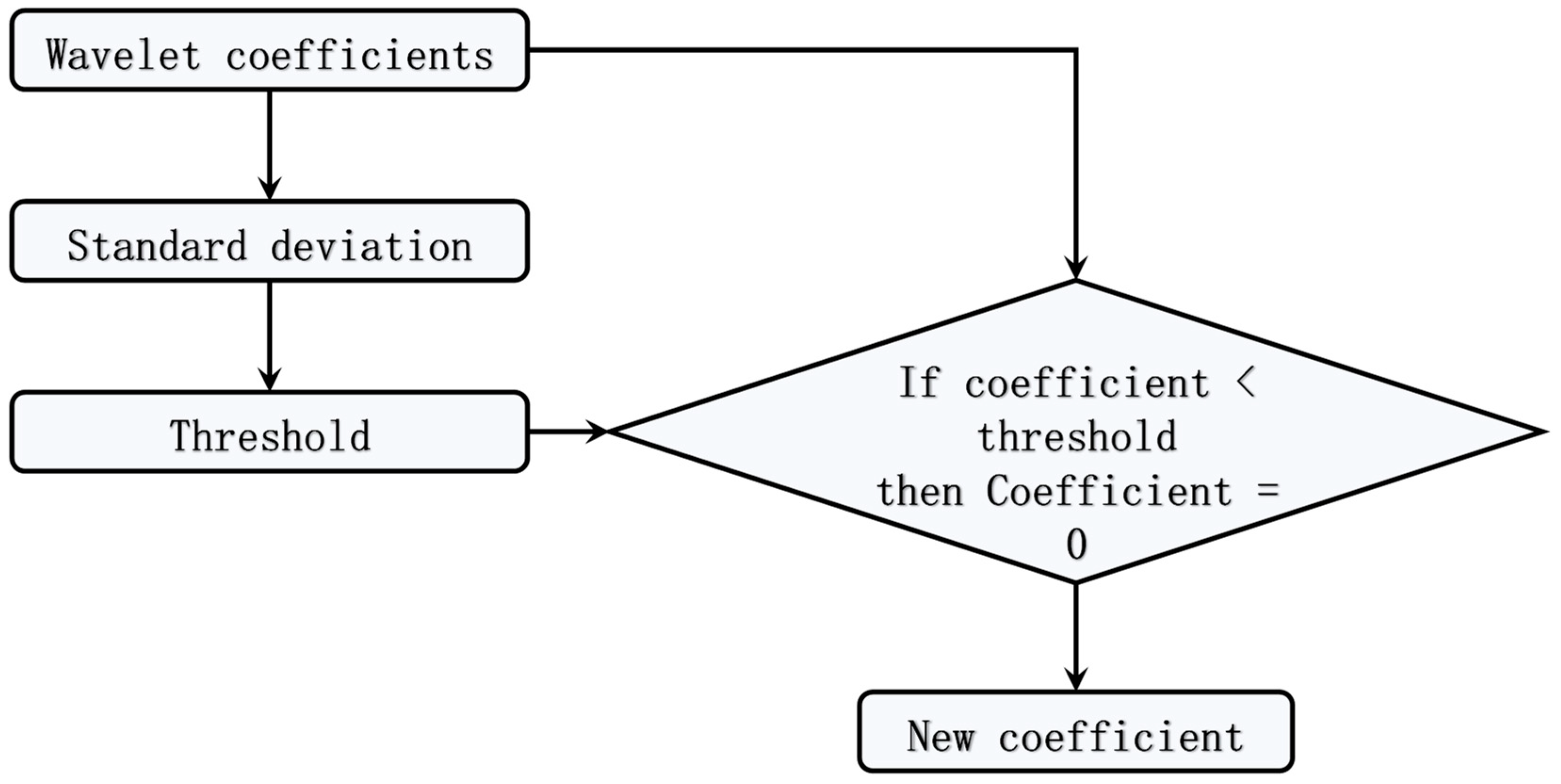

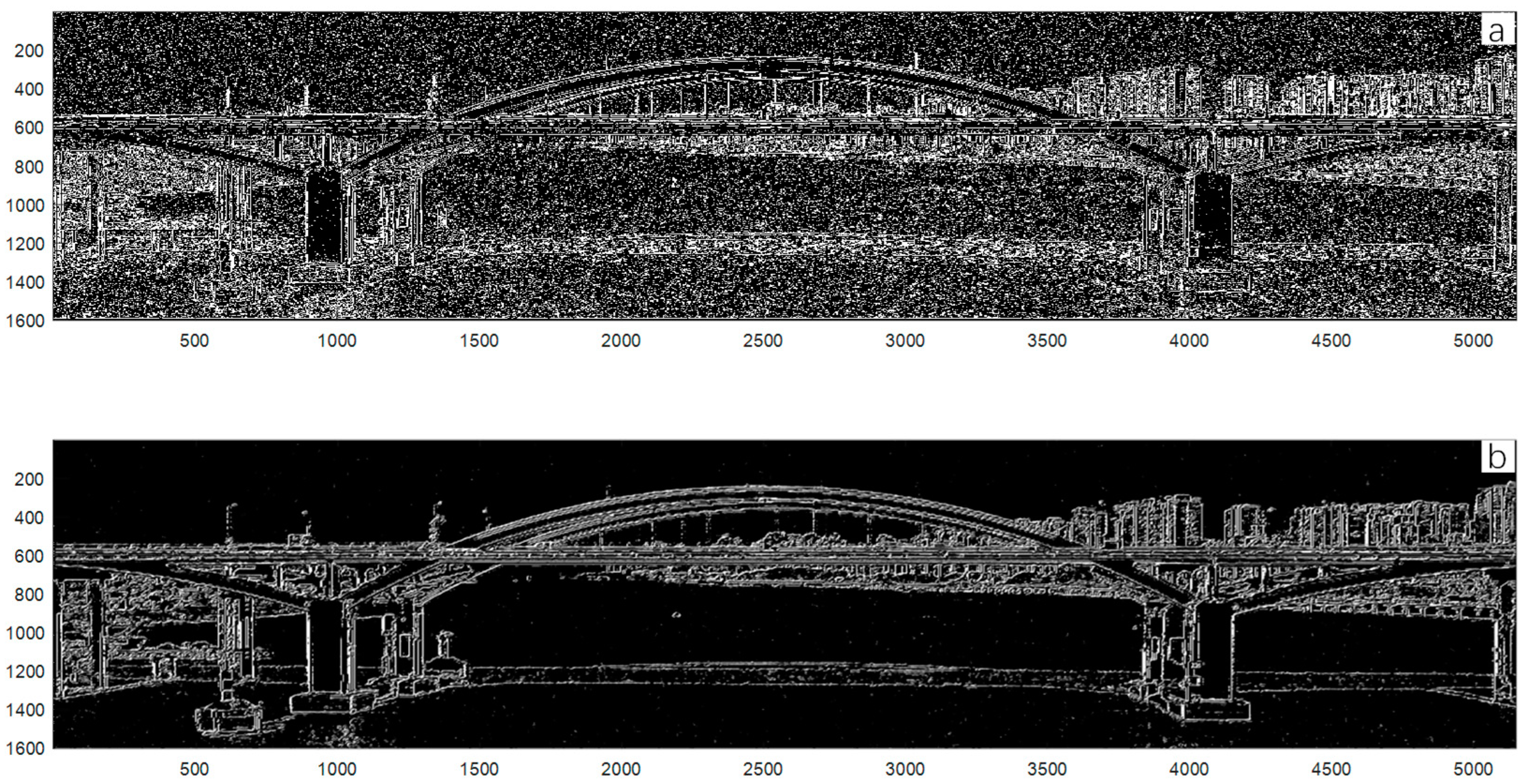
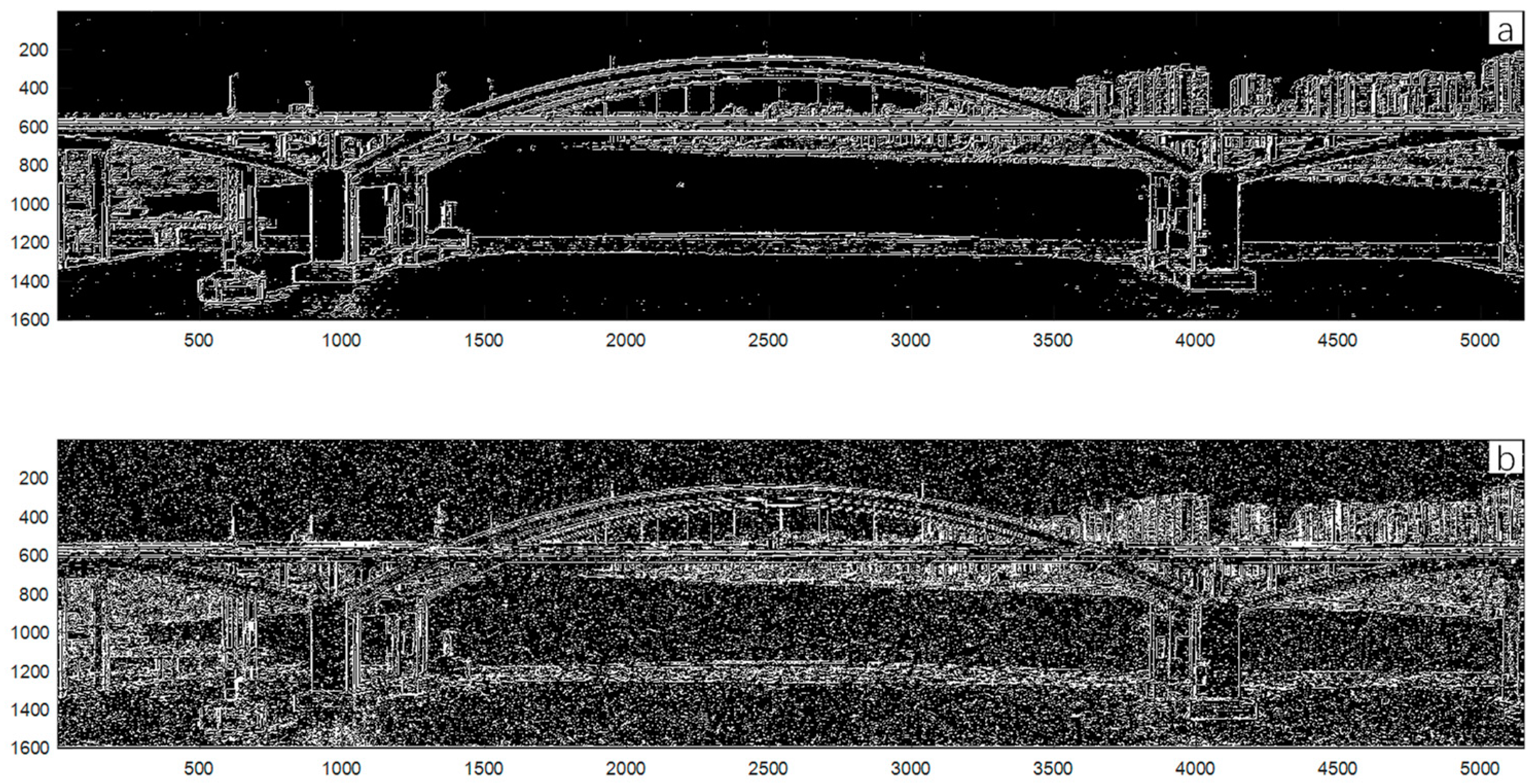

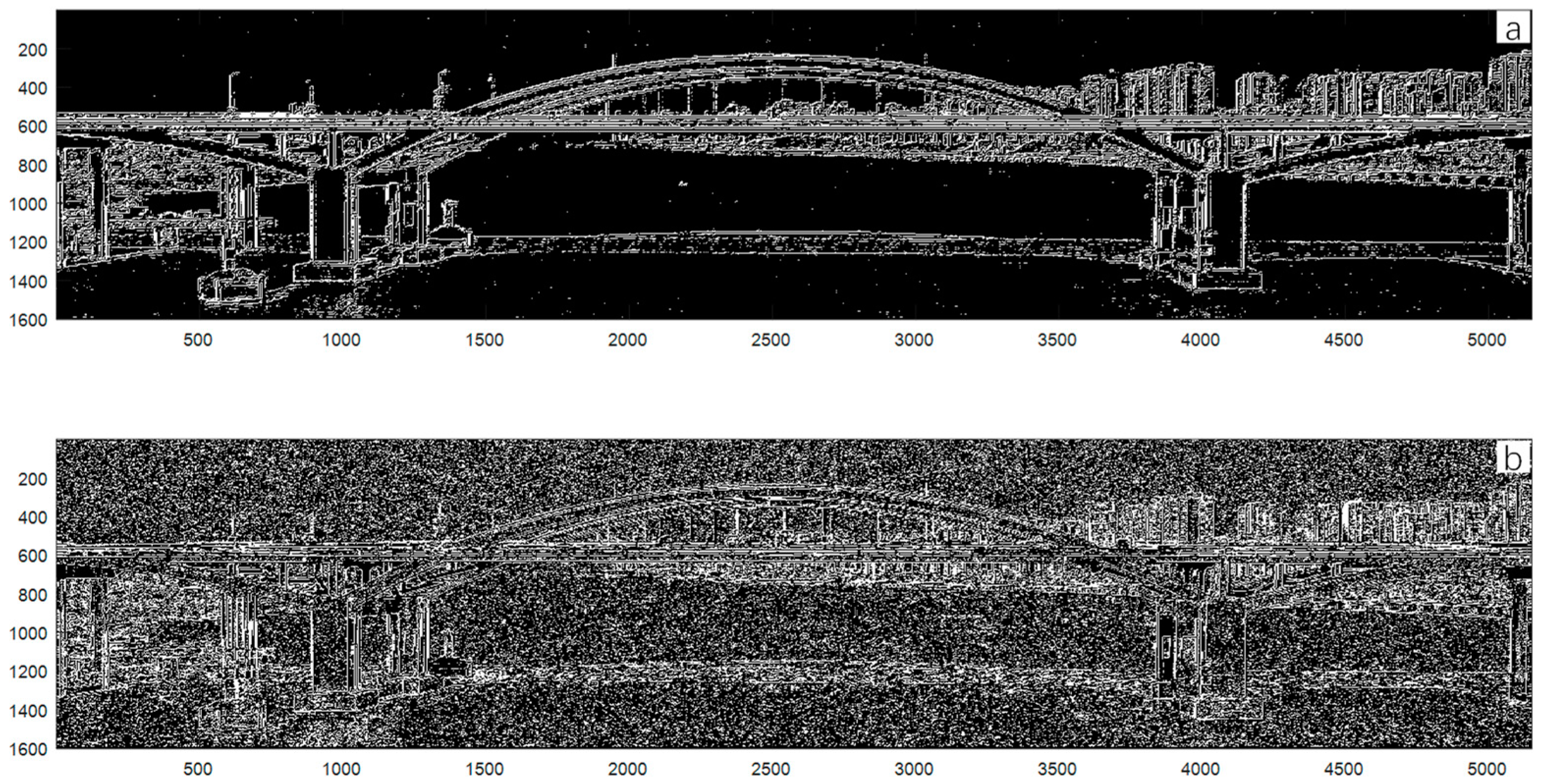
| Wavelet Functions | PSNR (dB) | MSE |
|---|---|---|
| sym5 | 23.48 | 299.49 |
| db5 | 23.37 | 300.53 |
| coif5 | 23.22 | 309.89 |
| fk6 | 23.28 | 305.40 |
| Levels | PSNR (dB) | MSE |
|---|---|---|
| 2 levels | 17.14 | 1251.00 |
| 3 levels | 23.48 | 299.49 |
| 4 levels | 23.31 | 303.25 |
| 5 levels | 22.72 | 347.75 |
| Denoising Method | Pratt Quality Factor |
|---|---|
| Gaussian Filter | 0.47 |
| Wavelet Transform | 0.53 |
| Salt and Pepper Noise | Poisson Noise | Multiplicative Noise | ||||
|---|---|---|---|---|---|---|
| Denoising Method | PSNR (dB) | MSE | PSNR (dB) | MSE | PSNR (dB) | MSE |
| Wavelet Transform | 23.58 | 285.21 | 23.53 | 288.14 | 23.46 | 293.29 |
| Gaussian Filter | 23.50 | 290.40 | 23.48 | 291.47 | 23.22 | 309.78 |
Disclaimer/Publisher’s Note: The statements, opinions and data contained in all publications are solely those of the individual author(s) and contributor(s) and not of MDPI and/or the editor(s). MDPI and/or the editor(s) disclaim responsibility for any injury to people or property resulting from any ideas, methods, instructions or products referred to in the content. |
© 2023 by the authors. Licensee MDPI, Basel, Switzerland. This article is an open access article distributed under the terms and conditions of the Creative Commons Attribution (CC BY) license (https://creativecommons.org/licenses/by/4.0/).
Share and Cite
You, N.; Han, L.; Zhu, D.; Song, W. Research on Image Denoising in Edge Detection Based on Wavelet Transform. Appl. Sci. 2023, 13, 1837. https://doi.org/10.3390/app13031837
You N, Han L, Zhu D, Song W. Research on Image Denoising in Edge Detection Based on Wavelet Transform. Applied Sciences. 2023; 13(3):1837. https://doi.org/10.3390/app13031837
Chicago/Turabian StyleYou, Ning, Libo Han, Daming Zhu, and Weiwei Song. 2023. "Research on Image Denoising in Edge Detection Based on Wavelet Transform" Applied Sciences 13, no. 3: 1837. https://doi.org/10.3390/app13031837
APA StyleYou, N., Han, L., Zhu, D., & Song, W. (2023). Research on Image Denoising in Edge Detection Based on Wavelet Transform. Applied Sciences, 13(3), 1837. https://doi.org/10.3390/app13031837





